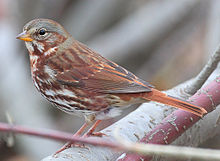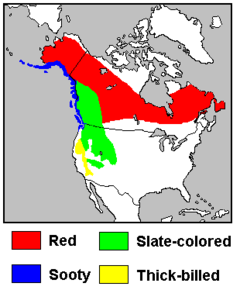Fox sparrow
| Fox sparrow | |
|---|---|
 |
|
| Red fox sparrow (P. i. iliaca), Whitby, Ontario | |
| Scientific classification | |
| Kingdom: | Animalia |
| Phylum: | Chordata |
| Class: | Aves |
| Order: | Passeriformes |
| Family: | Emberizidae |
| Genus: |
Passerella Swainson, 1837 |
| Species: | P. iliaca |
| Binomial name | |
|
Passerella iliaca (Merrem, 1786) |
|
 |
|
| Breeding ranges of the four fox sparrow groups | |
The fox sparrow (Passerella iliaca) is a large American sparrow. It is the only member of the genus Passerella, although some authors split the species into four sub-species (see below).
More specific information regarding plumage is available in the accounts for the various taxa.
Adults are amongst the largest sparrows, heavily spotted and streaked underneath. All feature a messy central breast spot though it is less noticeable on the thick billed and slate-colored varieties. Plumage varies markedly from one group to another.
These birds forage by scratching the ground, which makes them vulnerable to cats and other predators, though they are generally plentiful. Fox sparrows migrate on the west coast of the United States.
They mainly eat seeds and insects, as well as some berries. Coastal fox sparrows may also eat crustaceans.
Fox sparrows nest in wooded areas across northern Canada and the west coast of North America from Alaska to California. They nest either in a sheltered location on the ground or low in trees or shrubs. A nest typically contains two to five pale green to greenish white eggs speckled with reddish brown.
The review by Zink & Weckstein (2003), which added mtDNA , NADH dehydrogenase subunit 2 and 3, and D-loop sequence, confirmed the four "subspecies groups" of the fox sparrow that were outlined by the initial limited mtDNA haplotype comparison (Zink 1994). These should probably be recognized as separate species, but this was deferred for further analysis of hybridization. Particularly the contact zones between the slate-colored and thick-billed fox sparrows which are only weakly distinct morphologically were of interest; the other groups were found to be distinct far earlier. A further study of the nuclear genome, using microsatellites, showed similar separation between the four groups.
...
Wikipedia

